
B2B marketing strategies and sales processes have matured and even plateaued in the last few years. Prospects are being flooded with sales tactics they know and have grown tired of, including poorly researched questions and generic messages.
425,698.
That’s the number of new businesses registered in the United States in July alone. With more options for consumers to pick from, converting leads is becoming more difficult, especially for B2B sales teams. To make matters worse, sales reps keep repeating the same B2B sales mistakes without even knowing them.
To help you nurture more leads and close more deals, here are nine simple but powerful B2B sales strategies that you can (and should) start implementing now.
10 B2B sales strategies to win more clients
For the most part, increasing your sales doesn’t require fancy tactics or expensive software. It all comes down to the fundamentals. Let’s take a look.
1. Do your deep research
B2B marketing strategies and sales processes have matured and even plateaued in the last few years. Prospects are being flooded with sales tactics they know and have grown tired of, including poorly researched questions and generic messages.
When everyone is focused on the low-hanging fruit and quick wins, the best way to get results is to research better. Deep research is what will separate you from your competitors.
Psychographics, not just demographics
Before reaching out to a prospect, dive deep into their buyer persona, which should be based on the problems rather than just demographics.
For example, generic demographics would place Charles, Prince of Wales and Ozzy Osborne together. Both share similar age, financial, marital, and social status. Sales reps that lead with generic personas have a hard time selling a product.

Image source
Instead, you should lead with pain points, fears, goals, and aspirations. This is true for both B2C and B2B sales because, at the end of the day, you’re selling to people who are looking to get things done.
Go for the decision-makers
Another mistake sales reps often make is reaching low-level buyers. Each company has a bunch of roles that are “out there,” but they rarely contribute to the decision table. Focus on decision-makers who have the power to say “yes” and not the first ones that come up in a quick search.
2. Listen more than you talk
Securing the attention of a busy buyer is an uphill battle, so it only makes sense to close right away, right?
Wrong.
A lot of sales reps are guilty of this mindset as they push buyers too hard, too early. It might work in B2C but certainly not in B2B. Unless you’re pioneering an entire industry, you’re not the only company pitching, and it’s off-putting from a buyer’s perspective to see reps focusing on the sale alone.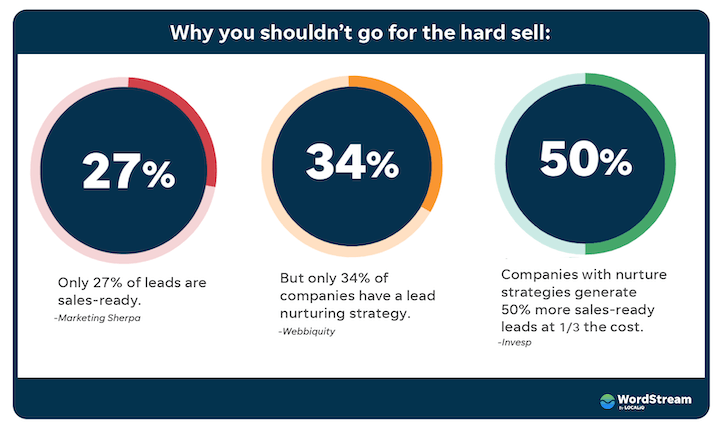
Only 27% of leads are sales-ready, yet only 34% of companies have a lead nurturing strategy.
Rather than going in for the hard sell and explaining everything over the call, make the prospect feel heard and seen. Here’s how.
Ask questions
Ask big questions about the company that make the prospect think. Questions that:
- Complement their perspectives.
- Show you’ve done your deep research across the company, employees, decision-makers, competitors, and the industry.
- Allow you to gather small details that you can bring up later, to show that you were paying attention.
Listen to the answers
Let them talk. While listening, you’ll pick up cues that will help you nurture the relationship. When you take time to build one-on-one connections, you not only edge out the competitors and make the sale but also build client relationships that last. According to Invesp, companies that excel at lead nurturing generate 50% more leads at a third of the cost.
Include personal details
Things are not too different when you’re emailing for the first time. Initial outreach should reflect the depth of your research. When cold emailing to prospects, lead with recent developments in the company or even a personal milestone. Once you secure their attention, bake your service or product in naturally and help them see the short-term and long-term impact.
Far too many salespeople focus on hard-selling without thinking that recurring and happy, loyal customers are way more valuable than one-time revenue.
3. Do not hurry your prospects
Making a B2B sale means going through a number of decision-makers and touchpoints before closing.
When you push a buyer into making a quick decision, it shows you haven’t done your research into the company’s internal processes. Apart from coming across as a novice, you also end up pushing people away.
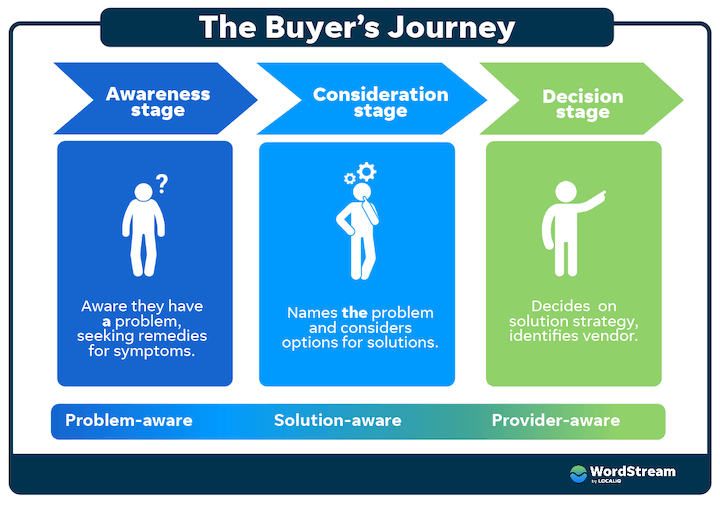
When you spend time understanding the business, you also find its triggers and challenges. After establishing contact, focus on acquiring buy-in from other stakeholders to expedite the process.
For example, if you’re selling logistics software, ask for a meeting with the warehouse staff to note down the challenges they face, compile all the data, and present a compelling case to the executives.
Bottom line: Respect the time needed to close a deal.
4. Engage your existing customers
Before going out to chase new leads, look into your existing database to see if there’s an opportunity. You’re 65% more likely to sell to existing customers than new ones. Existing customers are also 31% more likely to spend more on your offers.
Userlane researched the product adoption journey and found that 60% of new SaaS features were completely unexplored by customers. Beyond the sign-up rush, the highest uptick in customer engagement came when new features were sold to existing customers, leading to negative churn.
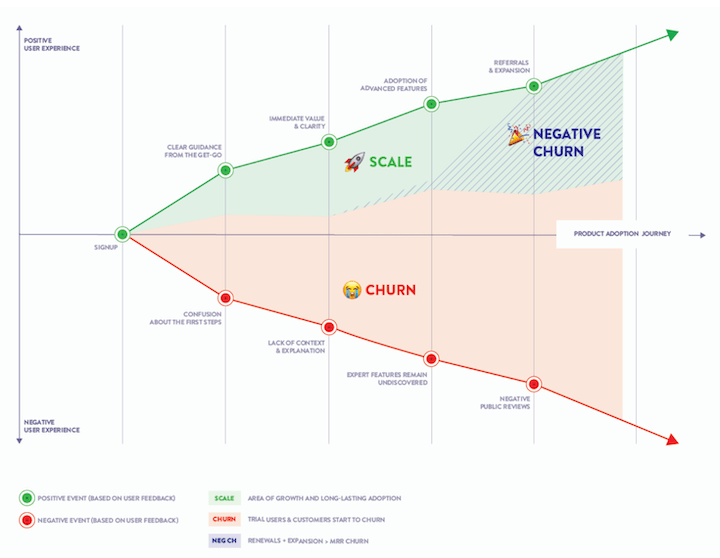
Image source
When you prioritize existing customers, you bring down your cost of acquisition, upsell more, and strengthen partnerships. CRMs and sales intelligence tools unearth adequate data for you to analyze which customer will fall off the grid soon or is more likely to buy your new product.
But B2B automation tactics and tools will only take you so far. Stay in touch with your old customers and schedule frequent calls to see how they are using your products, what new features they’d like, and what new challenges they’re looking to solve.
They’ll often give you first-party insights into product use cases and selling opportunities you didn’t know you needed. You can use that data to retarget them or sell to new prospects. Either way, don’t miss out on your existing fans because your job there is already half-done.
5. Stick to your price sheet
One of the major B2B sales mistakes is trying to differentiate on price. Sales reps often think that the cheaper they quote, the easier it will be to convince the prospect. They couldn’t be more wrong.
If your product can successfully achieve what it claims to do, there’s no point in underpricing yourself.
The image below paints an accurate picture of SaaS applications raising their prices based on the value they offer to high-end clients.
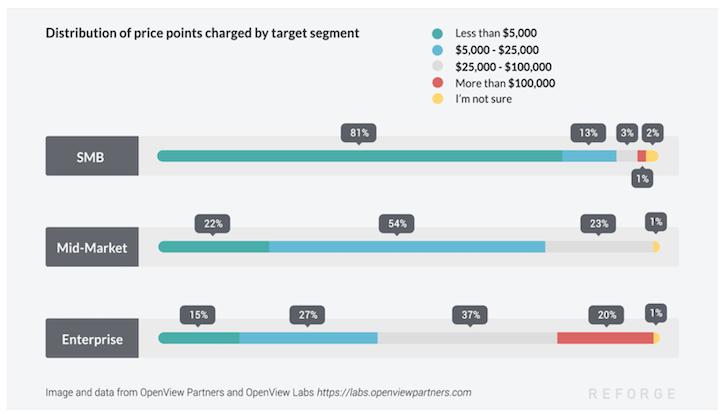
If you’re worried that pricing will derail a conversation, here’s a secret: Confidence is a powerful tool in sales, and it’s infectious. Stick to the predefined price sheet and lead the conversation with the benefits and the importance of the product.
If you can convince a prospect on the right aspects of the offer, price becomes secondary. This way, you not only close bigger value contracts but also create an impressive brand image.
B2B teams can learn a lot from Apple’s B2C strategies: Focus on things that matter most to customers, try to execute better than anyone else, scale fast, and eventually push prices out of the conversation.
That said, if you’re not sure about your pricing strategy, create a three-tier plan to give more options to the buyer. But make sure you don’t overwhelm them with too much information and actually explain each tier properly.
6. Focus on benefits over features
B2B buyers have long ignored features and prioritized direct benefits. They rarely ask you how a product works because they want to know what value it brings so they can decide if it will bring a positive ROI for their company.
But why is it so hard to transition from features to benefits, despite knowing better? It’s because features are baked into product development, whereas benefits require you to be detached and look at the product from a distance.
Salespeople, often being too close to the product, fail to see and communicate the big picture. Obsessing over features also means you disregard the buyer’s domain knowledge.
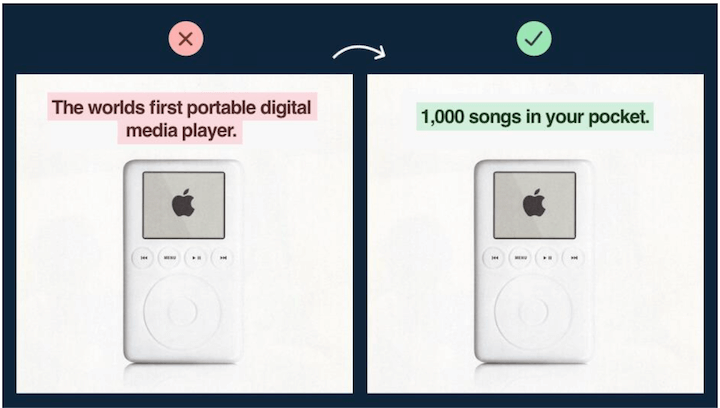
Image source
Steve Jobs and his team, despite working on a technological marvel that changed the music industry forever, didn’t describe the features of iPods but showed what people could do with them.
The best ways to show benefits today are testimonials from similar customers, free product demos, and traceable impact in numbers. Instead of boasting about your new lines of code, help customers see what they can achieve with your products and witness your sales skyrocket.
7. Follow up with your sales leads…
Many sales reps want to build long-term relationships and nurture leads, but they fail to implement the first step: follow-ups. According to an Invesp study, 44% of sales reps don’t follow up after the first time.
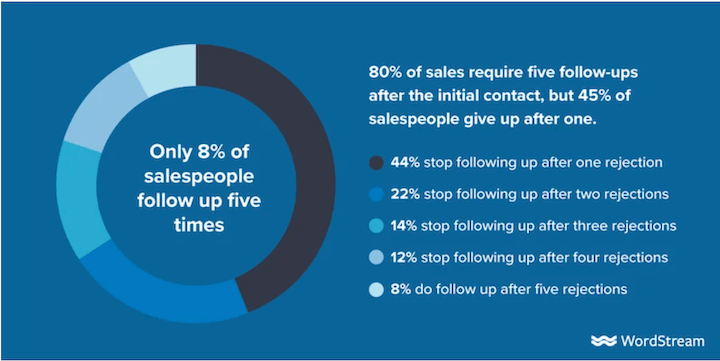
But here’s the kicker: 60% of customers reject the first four offers before saying “yes.”
The B2B buying wheel is full of cogs, and chances are, your prospect doesn’t have the time to look over the offer right away. What you can do is stay in touch and follow up consistently.
Following up with sales leads allows you to stay top of mind so even if the prospect doesn’t need your product right now, they can always call back at the right moment. Most sales reps give up on prospects too soon, so the one that hangs in there usually makes the final sale.
8. …via email…
Emails are great for following up because they are less annoying than calls, and you can be easily redirected to the next decision-maker if the current one is too busy.
Follow-up emails should summarize the previous interactions and offer new value or a perspective on the product. Simply put, your sales follow-up emails shouldn’t sound like the same message being repeated over and over again. The line between respectful persistence and being annoying is thin, so tread lightly.

Image source
9. …but overall, use multiple communication channels
According to McKinsey, B2B buyers communicate on 10 or more channels with their suppliers. In a post-pandemic world, omnichannel marketing and sales strategy is not a competitive edge anymore—it’s an expectation. Buyers actively seek 24/7 presence from you, and they are not content with just phone calls or emails.
To maximize B2B sales, you need to use all available communication channels to nurture leads and build authentic connections. This means your sales strategy needs to be curated for different social media platforms, emails, text messages, Slack, Zoom, phone calls, and offline meetups.

Using different channels helps you keep your outreach strategy fresh and innovative, and it’s less intrusive this way. For instance, if you’re following up on a sales call using LinkedIn, you can use a relevant topic you saw the prospect discussing to plug your product. When you’re discussing in Slack, you can record a quick tutorial to address a concern.
10. Measure your performance
In general, sales relies as much on soft skills as on data. If you have been struggling to meet your target, there’s a possibility you’re making the same mistakes you did a couple of months earlier.
Sales reps need to go back to the dashboard to constantly evaluate their performance and derive insights from data. The insights give a clear road map that can be implemented to improve sales tactics.
While modern CRM and sales enablement tools are goldmines of data, make sure you focus only on specific KPIs. The filters can give you widely contradicting and overwhelming numbers, so it’s important to focus on the right insights. Databox offers customizable sales dashboards that track targeted KPIs for different segments of sales teams.
Source: https://www.wordstream.com/blog/ws/2022/09/09/b2b-sales-strategies


